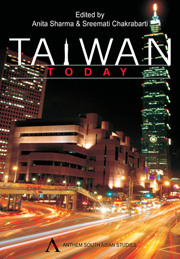Book contents
- Frontmatter
- Contents
- Acknowledgements
- Contributors to this Volume
- Acronyms and Abbreviations
- Foreword
- Introduction
- 1 Who are We? Identity in Transition
- 2 Taiwan: Yearning for an Identity
- 3 The Implications of Direct Flights: Beijing in Taiwanese Politics
- 4 Kuomintang, Democratization and the One-China Principle
- 5 The Deepening and Consolidation of Democracy in Taiwan
- 6 India and Taiwan: Bolstering Complementarity in Information Technology
- 7 Asian Regional Economic Integration and Taiwan–India Economic Relations
- 8 The Taiwan Factor in Sino–Indian Relations
- 9 Japan's Triumphant Diplomacy in Taiwan in 1874
- 10 A Study of the Cultural and Educational Exchanges between Taiwan and India, 1995–2006
- 11 Between Two Worlds: A Survey of Education in Taiwan
- 12 Female Immigrants, Social Capital and Public Sphere in Taiwan
- 13 Information Technology and Gender: Taiwan and India
- 14 Tzu Chi: A Case Study of Engaged Buddhism in Taiwan
- 15 Master Hsing Yun of Fo Guang Shan and the Development of Humanistic Buddhism
- 16 The Heritage and Innovation of Chan Paintings in Taiwan
- 17 Taiwan in World Architecture: A Historical Perspective
- Afterword
17 - Taiwan in World Architecture: A Historical Perspective
Published online by Cambridge University Press: 05 March 2012
- Frontmatter
- Contents
- Acknowledgements
- Contributors to this Volume
- Acronyms and Abbreviations
- Foreword
- Introduction
- 1 Who are We? Identity in Transition
- 2 Taiwan: Yearning for an Identity
- 3 The Implications of Direct Flights: Beijing in Taiwanese Politics
- 4 Kuomintang, Democratization and the One-China Principle
- 5 The Deepening and Consolidation of Democracy in Taiwan
- 6 India and Taiwan: Bolstering Complementarity in Information Technology
- 7 Asian Regional Economic Integration and Taiwan–India Economic Relations
- 8 The Taiwan Factor in Sino–Indian Relations
- 9 Japan's Triumphant Diplomacy in Taiwan in 1874
- 10 A Study of the Cultural and Educational Exchanges between Taiwan and India, 1995–2006
- 11 Between Two Worlds: A Survey of Education in Taiwan
- 12 Female Immigrants, Social Capital and Public Sphere in Taiwan
- 13 Information Technology and Gender: Taiwan and India
- 14 Tzu Chi: A Case Study of Engaged Buddhism in Taiwan
- 15 Master Hsing Yun of Fo Guang Shan and the Development of Humanistic Buddhism
- 16 The Heritage and Innovation of Chan Paintings in Taiwan
- 17 Taiwan in World Architecture: A Historical Perspective
- Afterword
Summary
INTRODUCTION
Taiwan lies close to the Mainland of China on the Tropic of Cancer in the western Pacific Ocean. Taiwan was named Isla Formosa by the Portuguese in the sixteenth century. Taiwan has a rich historical background and a multifaceted culture because of a long history of residency of Taiwan's own indigenous people. Taiwan is home to 12 different tribes, southern Fujianese from early China, Hakka immigrants, Dutch, Spanish, Japanese and other recent immigrants from China. About 7000 years back, Austronesian ancestors of aborigines settled in Taiwan. They are the earliest known inhabitants of Taiwan.
During the fifteenth century, Chinese emigrants occupied the coastal areas. Numerous aboriginal tribes, entrepreneurs, pirates, traders, etc lived on the western side.
In the first half of the seventeenth century, the Dutch came to Taiwan and defeated the Portuguese to capture ‘Macan’ to trade with China and Japan. They controlled and exploited the island. They built forts, conducted missionary activities, engaged in trade, produced various goods, etc. The Spanish came shortly after the Dutch and settled in the north to trade with China and Japan but they were driven out by the Dutch who in turn were expelled by supporters of the Ming emperors. In 1684, Taiwan was conquered by the Manchu and officially became part of China.
The French came and briefly planted their flag in the north in 1885. They signed a treaty with the Manchu Qing and left.
- Type
- Chapter
- Information
- Taiwan Today , pp. 226 - 233Publisher: Anthem PressPrint publication year: 2010



